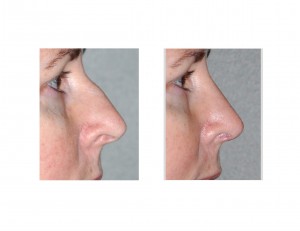The middle third of the nose is usually viewed as a mere bridge between the top of the nose and the tip. But it actually has a very significant functional purpose as what lies beneath it and is created by it is the internal nasal valves. Formed by the junction of the septum and the inner edge of the upper lateral cartilages, this creates the most constrictive part of the internal nasal airway for breathing. These conjoined cartilages also create the appearance of the nasal dorsum in this area known as the middle vault.

In addition to improving breathing, integrity of the internal nasal valves influences the outer contour of the middle vault. How the upper lateral cartilages articulate with the dorsal septum plays a central role in the brow to tip aesthetic lines. (dorsal aesthetic lines) Too much narrowing in the middle vault will produce an inward deviation to what would be an otherwise straight line resulting in an unaesthetic ‘hourglass’ or inverted V shape.
Spreader grafts are usually harvested from the septum, being just 1 to 2mms thick (wide) and up to 25mms long. As long as one has a good septum from which to harvest the spreader grafts, one’s own cartilage is always the best. But lack of good straight cartilage pieces may lead one to opt for synthetic materials, such as PDS, from which the fabrication of spreader graft shape and dimensions is easy and assured. While the synthetic material may resorb, it is replaced by scar tissue which may still serve a space-maintaining role long-term.
Dr. Barry Eppley
Indianapolis, Indiana



